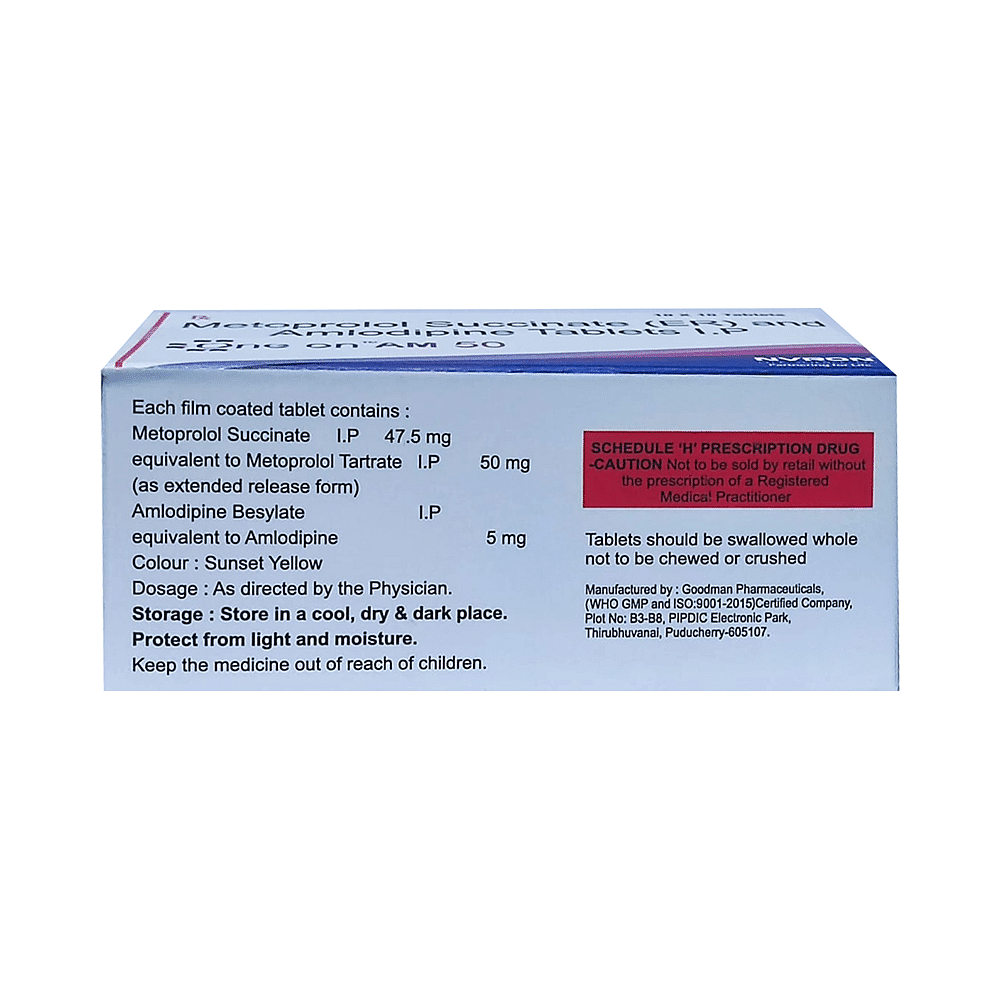


One on AM 50MG Tablet
Manufacturer
Nvron Life Science Ltd
Salt Composition
Amlodipine (5mg) + Metoprolol Succinate (0mg)
Key Information
Short Description
One on AM 50MG Tablet is a combination of two medicines that help control high blood pressure and heart rate, and is used for heart-related chest pain, abnormal heart rhythms, and chronic heart failure.
Dosage Form
Tablet
Introduction
One on AM 50MG Tablet contains two medicines that help to control high blood pressure and heart rate. It is also used for heart-related chest pain (angina), abnormal heart rhythms, and chronic (long-term) heart failure.
Directions for Use
Take this medicine in the dose and duration as advised by your doctor. Swallow it as a whole. Do not chew, crush or break it. One on AM 50MG Tablet may be taken with or without food but it is better to take it at a fixed time.
How it works
One on AM 50MG Tablet is a combination of two medicines:
Quick Tips
It may cause dizziness. Get up slowly when rising from a sitting or lying position. Do not stop taking the medication suddenly without talking to your doctor as it can cause sudden increase in your blood pressure. Let your doctor know if you are pregnant or planning for pregnancy.
Related Medicines

Metolar Am-50 Tablet

Best-Beta-AM 50 Tablet

Amlocaid-M Tablet

Corvadil M 5mg/50mg Tablet

Meritol AM 5 mg/50 mg Tablet

Winpres MT Tablet

Metapol AM 5mg/50mg Tablet

Betacon AM 5mg/50mg Tablet

Metozil AM 5mg/50mg Tablet

Ccblok M 5mg/50mg Tablet
Frequently asked questions
Can I stop taking One on AM 50MG Tablet if I feel well?
No, continue using One on AM 50MG Tablet as prescribed by your doctor, even if you feel well. Stopping the medication suddenly may lead to serious complications such as heart attack or stroke.
What are the instructions for the storage and disposal of One on AM 50MG Tablet?
Keep this medicine in its original container, tightly closed. Store it according to the instructions on the package label. Dispose of unused medicine safely, ensuring it is inaccessible to pets, children, and others.
Can the use of One on AM 50MG Tablet cause headache?
Yes, headaches can occur during initial treatment with One on AM 50MG Tablet. These headaches typically subside within the first week of treatment. If frequent or persistent headaches persist, consult your doctor.
What are the contraindications associated with the use of One on AM 50MG Tablet?
One on AM 50MG Tablet is harmful to patients who have allergies to its active or inactive ingredients. It should be avoided in individuals with a history of asthma or lung disease. Disclose your medical history and medication list to your doctor for proper evaluation.
Can I feel dizzy after taking One on AM 50MG Tablet?
Yes, the use of One on AM 50MG Tablet can cause dizziness. This effect may occur when you abruptly change positions from lying or sitting. To reduce the chance of experiencing dizziness or fainting, rise slowly when transitioning from a lying or sitting position.


